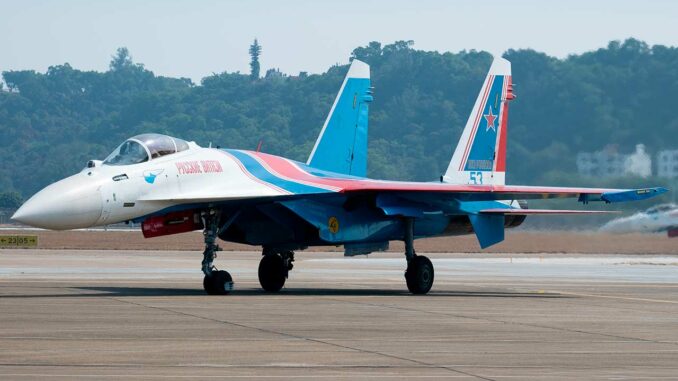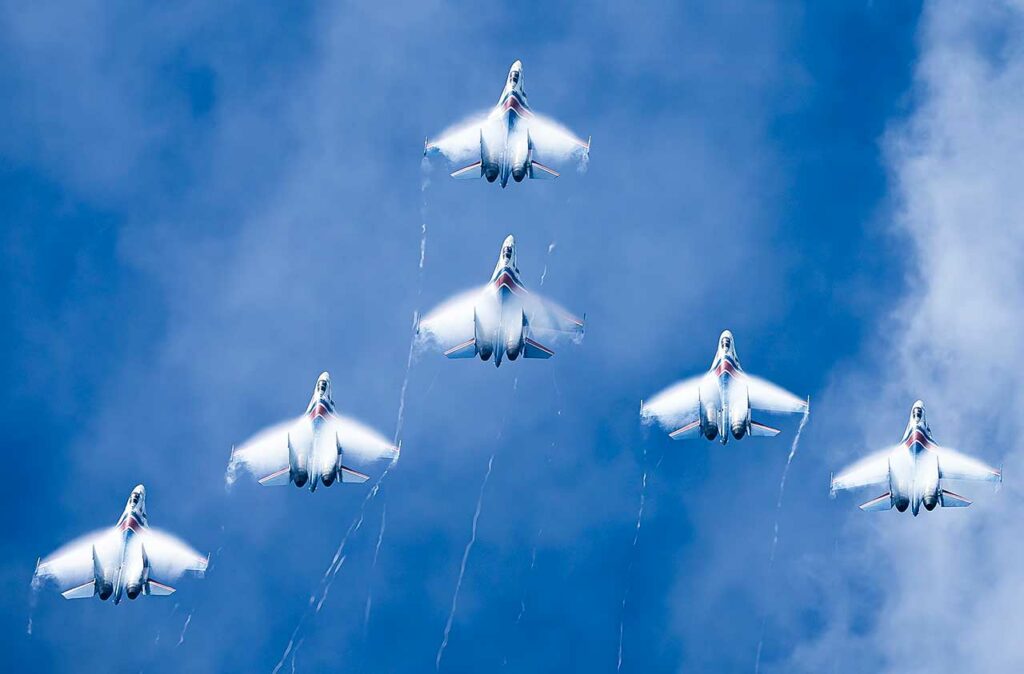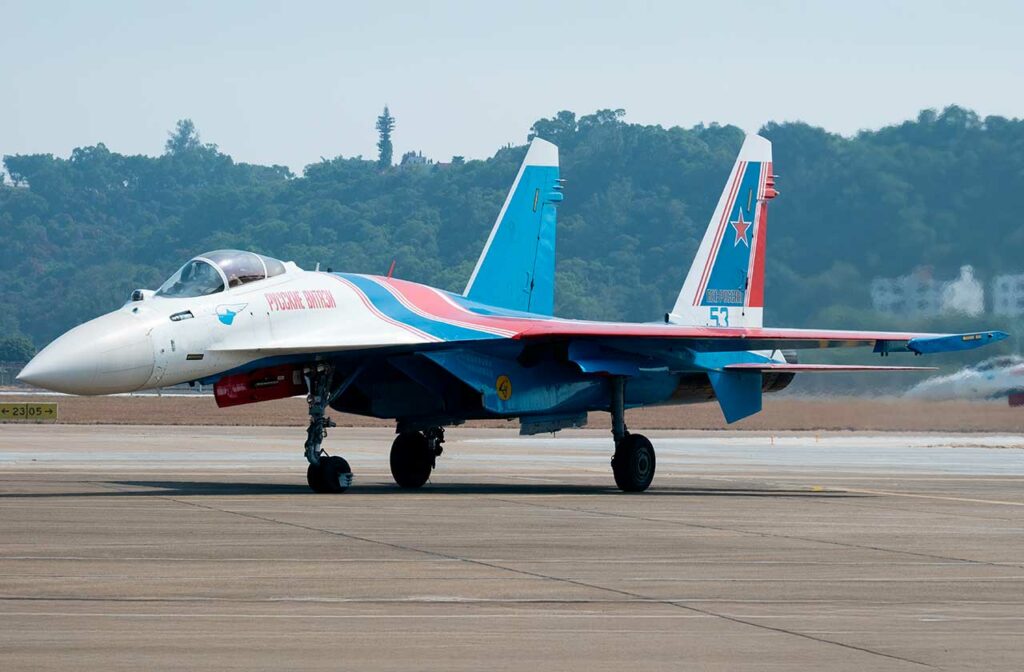
UAC delivers a new batch of Su-35S aircraft, strengthening Russia’s tactical fleet. Increased production and efficiency targets: +30% productivity by 2030.
In June 2025, United Aircraft Corporation (UAC) delivered a new batch of Su-35S fighters to the Russian Defense Ministry, strengthening the tactical fleet currently engaged in military operations in Ukraine. This “4++” generation aircraft, derived from the Su-27 platform, offers high air superiority and precision strike capabilities thanks to its advanced radar, thrust vectoring engines, and versatile tactical footprint. Rostec and UAC aim to increase productivity by 30% by 2030 to meet rising state orders, confirming a ramp-up despite Western sanctions.
Delivery and industrial context
In June 2025, the United Aircraft Corporation (UAC), the aviation branch of the Russian conglomerate Rostec, confirmed the delivery of a new batch of Su-35S fighters to the Russian Air Force. This delivery is part of the annual State Defense Order program aimed at strengthening the tactical fleet, particularly in the context of the conflict in Ukraine. This is the third shipment of Su-35S aircraft since the beginning of the year, following deliveries on March 29 and May 12, 2025.
The exact number of aircraft delivered has not been disclosed. However, based on previous deliveries of fighters in this category, the batches generally include between two and three aircraft. Thus, for the first half of 2025, it is reasonable to estimate that six to nine Su-35S have been integrated into the Russian forces. These figures are part of a ramp-up strategy announced in 2023, particularly for the Su-30, Su-34, and Su-35 ranges.
Before being transferred to operational units, each aircraft undergoes a complete industrial validation cycle. This process includes static ground tests, followed by test flights in various configurations: high and low altitude maneuvers, supersonic flight, weapons system evaluation, and avionics integrity verification. Once certified, the aircraft are flown to their bases, whose locations remain classified for operational reasons.
These deliveries confirm the industrial continuity of Russian military production despite Western sanctions and increased logistical constraints.
Key figures
- Three batches received between March and June 2025.
- Estimate: six to nine aircraft delivered in the first half of the year.
- Since 2012, approximately 135 Su-35S have been delivered.
- Total estimated inventory: 118 to 128 aircraft in service.
These figures illustrate sustained production, consolidated by Rostec’s decision to double the production rate (Su-30, Su-34, Su-35) since 2023.

Technical characteristics of the aircraft
The Su-35S is a multi-role fighter aircraft classified as 4++, which means that it is technologically between fourth and fifth generation aircraft. It is derived from the Su-27 Flanker, but has been extensively modernized to meet the contemporary requirements of high-intensity conflicts. The aircraft incorporates several technologies from the Su-57 program, particularly in terms of avionics, engines, and detection.
The Irbis-E radar, with passive electronic scanning (PESA), is a key feature. It can simultaneously track up to 30 air targets and engage eight of them. Its range can exceed 350 kilometers against a fighter-type target. This radar system gives the Su-35S multi-role detection capabilities, suitable for interception, hunting, and tactical support.
The aircraft is equipped with AL-41F1S engines with three-dimensional thrust vectoring, giving it exceptional super-maneuverability. It can withstand load factors of over 9 G, perform tight turns at low speeds and execute maneuvers that are impossible for conventional fighters. It also has limited supercruise capability, with supersonic flight at approximately Mach 1.1 without afterburner.
Its range is 3,600 kilometers without refueling, which is greater than most fighters in the same category. Its maximum payload is estimated at 8 tons, distributed over 12 hardpoints. Its armament includes long-range air-to-air missiles (R-77, R-73), guided air-to-ground missiles, laser- and satellite-guided bombs, and Kh-31 or Kh-35 anti-ship missiles.
Its unit cost, according to data available for the full export version, was around US$65 million in 2009, or approximately €60 million at current rates, excluding inflation and maintenance.
With this combination of range, maneuverability, and offensive payload, the Su-35S is competitive with aircraft such as the US F-15EX, while remaining less expensive than fifth-generation stealth aircraft. It thus constitutes an intermediate tactical platform, suited to Russia’s air power and regional projection needs.
Strategic challenges and mission in Ukraine
The Su-35S plays a central role in the Russian air force deployed in Ukraine since February 2022. Designed to provide air superiority in contested environments, it has been deployed intensively on several fronts, notably to counter drones, reconnaissance aircraft, and cruise missiles, as well as to support ground forces.
Its primary mission remains airspace control. The Su-35S is used to intercept Ukrainian aircraft, protect Russian bombers during strategic strikes, and suppress enemy air interdiction capabilities. Thanks to its long-range radar and R-77 missiles, it can engage targets at ranges of over 100 kilometers. This capability is essential to prevent the advance of TB2 Bayraktar armed drones, used by Ukraine in the early stages of the conflict.
The Su-35S is also being deployed for precision strikes against ground and naval targets. Equipped with multiband sensors, it can neutralize command centers, radars, and air defense systems, including positions equipped with Western missiles such as NASAMS or Patriot. Its high autonomy allows it to carry out long-range missions over Donbass or southern Ukraine without immediate refueling.
However, the aircraft’s performance must be put into perspective. According to the International Institute for Strategic Studies (IISS), several Su-35S have been shot down since the start of the conflict, mainly by Western ground-to-air systems (IRIS-T SLM, modernized S-300, and even Patriot PAC-3 missiles). Although not officially acknowledged by Moscow, these losses show that the aircraft is not invulnerable to modern, well-coordinated air defenses.
Despite these limitations, the Su-35S is still considered a key asset in Russian operations. It combines good survivability, a substantial payload, and flexibility in different types of operations, including in electronic warfare environments. Its presence also allows Russia to reduce the use of its rarer and more expensive Su-57s, reserving them for special missions.
Finally, data released by Rostec and the Russian command suggest that the Su-35S continues to undergo adjustments during operations: improved electronic countermeasures, enhanced coordination with tactical drones, and optimization of strikes on priority targets. In this context, its deployment in Ukraine is both a large-scale operational test and a lever for refining its future doctrine.
Production, productivity, and outlook for 2030
The Su-35S ramp-up target is part of a clearly defined industrial strategy by United Aircraft Corporation (UAC). According to Vadim Badekha, its CEO, production of these multi-role fighters remains stable and on schedule, with priority given to improving yields by 2030. The stated goal is a 30% increase in productivity at constant industrial capacity, without the massive deployment of new sites.
The nerve center of this production is the KnAAZ (Komsomolsk-on-Amur Aircraft Plant) factory, where the Su-35S is assembled. To achieve this growth, UAC is focusing on several technical levers: automating certain assembly stations, modernizing internal logistics lines, reducing duplicate operations, and optimizing work organization. At the same time, some human resources are being reassigned to higher value-added tasks or replaced by semi-automated systems in machining.
Rostec, UAC’s parent company, is also taking action upstream by consolidating supply chains for electronic and mechanical components. Despite Western sanctions, the Russian military-industrial complex has seen its activity increase its production volumes by a factor of 2 to 10 between 2022 and the end of 2024, depending on the category (tanks, artillery, aviation, ammunition). For aeronautics, this has resulted in an estimated annual production rate of between 6 and 12 Su-35S aircraft, depending on military priorities.
The plan is to exceed this average from 2026 onwards, reaching regular production of more than 15 units per year by 2030. This ambition is based in part on better integration of industrial management software, shorter supply times, and increased use of locally produced components, particularly to replace equipment that was previously imported.
Finally, these prospects are part of a strategy to respond to growing demand from the Russian Ministry of Defense. The volume of orders related to the state defense order (ГОЗ) for 2025 is already higher than that for 2024, forcing manufacturers to adjust their capacities without increasing their structural costs. By maintaining a sustained level of production while improving efficiency, UAC is seeking to stabilize the Su-35S fleet while preparing for the transition to fifth-generation aircraft such as the Su-57 and future derivative programs.

Consequences and future implications
The ramp-up of the Su-35S fleet has direct tactical and industrial effects. First, it strengthens Russia’s immediate military capability by consolidating its air superiority over Ukraine and stabilizing its posture vis-à-vis NATO forces in Eastern Europe. This increased presence improves air cover while supporting interdiction and reconnaissance operations.
Second, this densification of the fleet plays a deterrent role: the modernization of Russian air assets makes Western incursions or strikes more risky. However, this strategy comes at a cost. The priority given to Russian aviation is delaying planned exports to strategic customers such as Algeria (24 aircraft announced), Iran and Egypt, whose contracts now depend on remaining industrial capacity.
At the operational level, the concentration of Su-35S aircraft in a dense theater of operations is leading to an increasing logistical burden. Maintenance, spare parts, and servicing are increasing infrastructure requirements, while exposing more aircraft to Ukrainian defenses, such as the Patriot and S-300 systems.
Finally, the Su-35S is a transitional platform to fifth-generation aircraft. Its innovations (radar, engines, weapons systems) form a technical basis for the future Su-57 and related programs.
Even without complete stealth, the Su-35S remains a highly capable fighter thanks to its maneuverability, range, and power. Its industrial modernization responds to the pressure of the conflict in Ukraine and sanctions. With a productivity target of +30%, the program is calibrated to maintain the fleet beyond 2025, ensure Russian tactical air superiority, and prepare the next generations of fighters. This is a powerful, pragmatic, and technically sound industrial strategy.
War Wings Daily is an independant magazine.